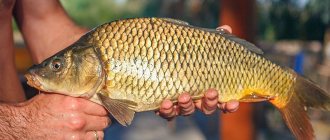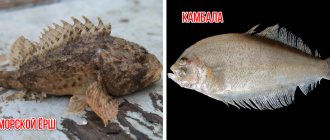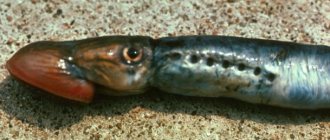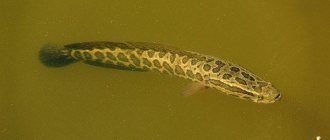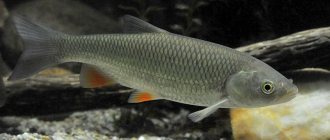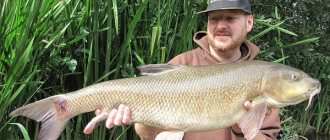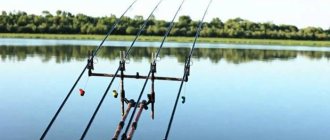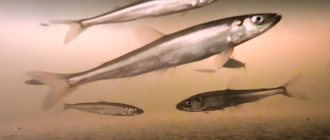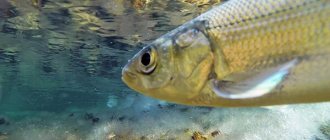- Wild animals
- >>
- Fish
The dace is quite modest in size, but has extraordinary agility and mobility, so only an experienced fisherman can catch it. The excitement of fishing is serious, because here you need to show all your dexterity and agility. Let's try to figure out what kind of underwater life the dace leads, how it stands out among other fish, what it prefers for lunch, where it is constantly stationed and how it spawns?
Origin of the species and description
Photo: Yelets
The dace is a ray-finned fish and belongs to the family Cyprinidae, the order Cypriniformes and the genus Dace.
The most common is the common dace, but there are two more subspecies of this fish:
- the Kyrgyz dace has chosen the waters of Kyrgyzstan and Kazakhstan;
- Siberian dace inhabited Siberian rivers.
There are also subspecies of fish belonging to the genus dace, among them are:
- Zeravshan dace;
- Transcaspian dace;
- Danilevsky dace;
- Talas dace.
Common characteristic features are common to all subspecies, but there are also specific differences. The Danilevsky dace has a dark gray or black ridge, and the scales on the sides are silver-gray. The fins located below are yellow-orange or yellow-red in color. The iris of the eye has a yellow-orange tint.
Video: Yelets
The Siberian dace has a dark green back and silvery sides. The color of the fins may be slightly reddish or completely whitish. The body shape of this fish is higher than that of an ordinary dace, the appearance of which we will describe in detail below. The Siberian is also distinguished by its terminal mouth.
It is worth noting that the appearance of dace and their dimensions are largely determined by the places of their permanent location and the presence of food supply in the reservoir. These fish are not distinguished by their large size and large shape. On average, the body length of a dace is about 15 cm.
Interesting fact: There is recorded data that the length of the largest dace caught was 40 cm, and its weight was equal to one kilogram.
Description of the fish
The dace is a tiny predatory fish that is found in many regions of the Russian Federation, central Europe and the United States of America. This species is not of particular commercial value, but it is very popular among fishermen. And although the body of the fish is covered with many small bones, it is often used to prepare delicious dishes and real culinary masterpieces.
Under natural conditions, the body length of the dace rarely reaches 15-20 centimeters, and the maximum weight is 200 grams. Life expectancy does not exceed 10 years. The belly of the small predator is painted white and silver, the back is gray-blue, and the fins are completely gray with a characteristic yellow tint. A distinctive feature of the fish is its massive snout, which is much wider than its forehead. The body shape is slightly elongated in the lateral part.
As for the lateral and anal fins, as they grow older they acquire a yellow color, while during the spawning period the anal fin is almost bright red. Because of this feature, dace is often confused with chub.
Among the existing species of fish that are found in Asia are:
- Siberian dace - lives in the reservoirs of Siberia and plays an important commercial role.
- Kyrgyz dace - found in Kazakhstan and Kyrgyzstan.
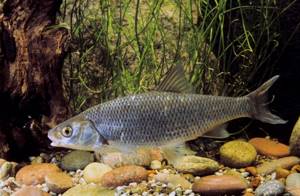
When choosing habitats, dace prefers small rivers with clean water and weak or medium flow. Sometimes it can be found in a flowing lake or floodplain reservoir, the bottom of which is strewn with stones and has a hard surface. The predator is not interested in muddy places.
Appearance and features
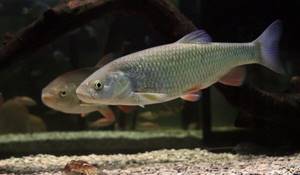
Photo: What a dace looks like
Dace is a freshwater fish that prefers rivers with clean water, rich in oxygen and a rocky bottom. As already mentioned, the most common sizes of fish range from 15 to 20 cm, and their weight rarely exceeds two hundred grams. The body of the dace is elongated and compressed from the sides, the overall predominant tone of the scales is silver. A darker bluish tint is noticeable on the back, and in the area of the sides and belly the color of the fish is light.
The dorsal fin is truncated and the caudal fin is elongated, they are colored in dark colors, and the fins located in front, as well as the anal rear fin, have a gray tint with a reddish-yellow coating. There are no spots, stripes or other patterns in the color of the dace; a monochromatic silver color scheme predominates, only the ridge is darker in color.
Interesting fact: The color scheme of the fins changes depending on the age of the fish; it acquires a more yellow tone. During the spawning period, the male's anal fin turns deep red.
The head of the dace, relative to the size of its body, is proportional and slightly narrowed. The fish is distinguished by a small semi-lower mouth, in which a two-row arrangement of pharyngeal teeth is observed. The number of gill rakers in dace varies from 8 to 10 pieces. The fish has medium-sized scales; along the lateral line there can be from 45 to 55.
The iris of the common dace is black. The appearance of the dace is similar to the characteristic features of the chub, but the former is distinguished by a narrower body and head. There is also a characteristic notch on the anal gray-yellow fin of the dace, while in the chub it has a semicircular shape and a red color.
What does a dace look like?
Common dace fish have a number of characteristics with which you can recognize the fish and distinguish it from similar ones. His body is oblong, compressed at the sides. The scales are tightly set and relatively large, silver-bluish in color, while the back has a violet-blue tint.
The fish itself is not very remarkable; to recognize it for sure, you need to remember that each fin of the dace is a dull gray hue, and the pelvic and anal fins are distinguished by a yellowish pattern with a white border. It is easiest to distinguish a female from a male by eye during spawning - in males these same patterns become redder, and females get a more orange and less saturated color. The dorsal fin is rather shortened, and the caudal fin has a deep section in the middle.
The common dace, which belongs to the family of carp fish, has a couple of subspecies that differ very slightly from each other in size and external features, but the internal structure of the fish is completely identical. Today there are only two varieties of dace:
- Yelets Siberian. From the Latin "Leuciscus leuciscus baicalensis". It lives mainly in natural and artificial reservoirs of Siberia; this dace is used for fishing - it occupies habitats in rivers in Kyrgyzstan and Kazakhstan.
Where does the dace live?
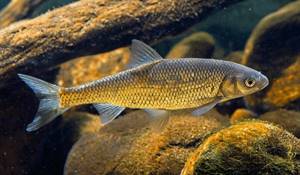
Photo: Yelets in Russia
Dace likes small rivers, where the current is not so fast and the water is clean and transparent. You can also meet this fish in the waters of flowing lakes, in some floodplain reservoirs, which it sometimes visits. Dace love rocky or sandy bottom surfaces. Where the bottom is muddy, you will not see this nimble fish. On the territory of our country, dace inhabits river systems and lakes of the Baltic and other southern seas. The fish has chosen the Siberian and Far Eastern waters.
Thus, Siberian dace can be found in tributaries:
- Kolyma;
- Yenisei;
- Obi;
- Lena.
This species of dace chooses small rivers, gathering in them in numerous schools, which often displace other fish inhabitants. Dace do not live in river systems belonging to the Pacific basin.
Let's consider the distribution area of dace, relative to its other subspecies:
- The Kyrgyz dace has chosen such rivers as the Nura, Chu, and Turgai. The fish lives in the waters of Kazakhstan and Kyrgyzstan;
- Danilevsky dace can be found on the Don and Dnieper;
- Talas dace lives in the lower reaches of Talas, in the Ass River, in lakes Ashi-Kul and Bayli-Kul;
- the Zeravshan dace inhabited the Amu Darya, Zeravshan and Syr Darya;
- Trans-Caspian dace is caught in the waters of the Tedzhen and Murghab rivers.
In the territories of Belarus and Ukraine, dace inhabits:
- Western Dvina;
- Desna;
- Dnieper;
- Northern Donets.
In the western part of Europe, dace lives in lake and river systems of the Baltic, Black Sea and North Sea basins. You will not find it in the areas of the Balkan and Iberian Peninsulas. This fish is considered sedentary, but much depends on the quality and purity of the water. If this indicator changes for the worse, flocks of dace swim upstream, looking for clearer water.
Interesting fact: Dace loves seething riffles, because... in such places the water has a high oxygen content.
Now you know where dace is found. Let's see what he eats.
Biological systematics
Dace are classified as chordates. Ichthyologists classify them as ray-finned fish of the carp family. This underwater inhabitant is classified as a separate genus of dace, which includes several subspecies. Scientific name "Leuciscus leuciscus".
Distribution, population and species status
Dace lives in many reservoirs in our region. Mainly lives in small rivers with clean and clear water. Loves currents and a hard bottom with a sandy or rocky structure. It is found in snagged areas, shallows and riffles, and when it gets colder it slides into holes. It is found in sufficient quantities in our reservoirs, but has no commercial significance. It is of exclusively sporting interest for lovers of float rods, bottom tackle, ultra-light spinning rods and fly fishing. Caught all year round.
Subspecies of dace
Common dace is common in our latitudes. In addition to it, several more subspecies are known:
- Kirghiz (leuciscus kirgisorum);
- Leuciscus danilewskii (Danilevsky);
- Lehmanni (Zerafshan);
- Transcaspian (Leuciscus latus);
- Siberian dace.
All varieties are similar to each other, differ in habitat and some external characteristics.
Comparison with other carp fish
Dace is similar to bleak, chub, ide and roach. Inexperienced amateurs often confuse these underwater inhabitants. Advanced fishermen can easily distinguish them by several characteristics, for example:
- The bleak has a more elongated body shape, a dark blue back, small scales, and the mouth is directed upward.
- The roach is distinguished by its bright fins, rounded body, and small mouth.
- The chub and ide are distinguished from the dace by their more coarse body, rounded head and large mouth.
Recommended reading: Chub fish
In general, learning to distinguish dace from similar representatives of the ichthyofauna is simple. It is enough to catch the listed fish species a couple of times and carefully examine them.
What does dace eat?
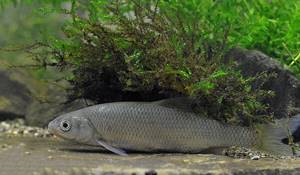
Photo: Dace in the water
The dace menu is quite varied; it includes dishes of both animal and plant origin. The latter are much smaller, but they are still present. Having a semi-lower mouth, the dace needs to swim tangentially, relative to the water surface, in order to quickly and deftly capture food.
The dace is very nimble and swift, so it is able to instantly pounce on anything edible that falls into the water. When dace feeds on the surface of the water, a small splash is heard, created by the fish's body when jumping.
In the summer, the fish diet consists mainly of all kinds of insects that live in the coastal zone (in tree crowns, bushes and grass near the water) and fall into the water. The dace also happily eats aquatic insects and their larvae.
So, fish like to snack:
- dragonflies;
- various beetles;
- butterflies;
- grasshoppers;
- flies;
- midges;
- bloodworm;
- mosquitoes;
- mayflies;
- Shitikami;
- caddis flies.
In winter, the menu mainly consists of:
- plankton;
- crustaceans;
- larvae;
- worms;
- rotifers;
- Daphnia, etc.
In the spring season, during high water, dace graze in floodplain meadows, where they also feast on worms, all kinds of bugs and larvae. As for plant foods, dace prefers to dine on filamentous algae, loves all kinds of cereals (oats, rye, wheat), and loves corn. All this can be judged by the contents of the stomachs of those fish that were caught.
Interesting fact: When the spawning period ends, dace begin to eat off, actively eating the eggs of other fish, causing them great harm.
If we talk about fishing, the tastes of dace change depending on the season. In spring, he likes worms, at the very beginning of summer he likes to eat caddisflies, and at the end of summer he prefers grasshoppers. Anglers should take note of this. Due to its selectivity to various baits, dace is considered a difficult catch; to catch it you need to try hard and study its habits.
Description
Dace is a typical freshwater fish.
She prefers to settle in rivers and lakes where running water is present. It loves fast currents, stays in small flocks and swims along the bottom of a reservoir covered with pebbles, stones and sand. Does not like swamp water, as it is a rheophile. It is very demanding on the aeration of water, that is, it prefers areas where it is saturated with dissolved oxygen. The fish feeds on animal food. The diet consists of mosquito larvae and other insects. However, it does not disdain filamentous underwater vegetation.
Features of character and lifestyle

Photo: Dace fish
Based on its fish diet, dace can easily be classified as a predator, and therefore it behaves accordingly: it waits in the stream of water, hiding behind various stones, bottom mounds, and snags. The fish instantly attacks insects swimming past or falling into the water. The dace also likes to hunt insects that fly low, almost at the very surface of the water. The fish, catching them, jumps out slightly, creating a small splash on the water surface.
Interesting fact: Dace can be called a schooling fish. Especially young fish, two- and three-year-old individuals live collectively, only older fish can live alone or in groups containing from 2 to 5 dace.
In the summer, when spawning ends, dace tend to the depths, staying near the bottom most of the time, and this is how they spend almost the entire summer. On the surface they can be seen only at dawn and at dusk, especially on bright moonlit nights, when fish hunt for swarms of insects clustered above the water surface. In search of food, dace can leave deep water and swim closer to rifts and reaches; when the fish are satisfied, they return back.
With the arrival of autumn, dace exist at a depth of 2 to 4 meters, and when it gets very cold, winter is approaching, they move to underwater holes, flocking into numerous flocks that hardly move, they are not looking for food at this time, so they cannot be caught by fishermen . Only with the onset of prolonged thaws do dace begin to move sluggishly, looking for food.
Fish revival occurs in February-March; before the start of the spawning period, dace leave their wintering holes. If we talk about the character and morals of the dace, then this fish can be called very mobile, nimble, active and quite smart. This small aquatic creature is no stranger to agility and speed. This is evidenced by various observations of fishing enthusiasts.
Interesting fact: If a fisherman discovers a place where dace is constantly stationed, he will only be able to catch 3 or 4 fish. The dace will immediately understand that it is better not to touch the bait and will swim away to another area. In order for the bite to continue, the angler needs to constantly change where he casts his fishing rod.
Social structure and reproduction
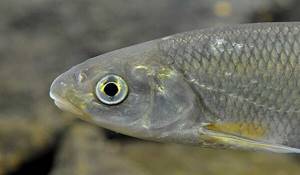
Photo: River fish dace
Dace become sexually mature closer to the age of three, by which time they grow to 10 or 12 cm. Schools of fish begin to rise upstream as soon as the spring ice drift begins. During a flood, dace swim into small tributaries where the water is clean and clear, and the spawning season begins, which begins in the first couple of spring months. During this period, the water should warm up to five degrees plus, sometimes more. If the weather does not cooperate and the water is still cold, then the wedding fish season will be postponed for some time.
During spawning, there is noise on the river; numerous flocks are active and splash in the coastal zone. Spawning is performed at a time, this process takes from 3 to 5 days. The female lays whitish and fairly large eggs on bottom stones and aquatic plants. One egg reaches 2 mm in diameter. The fertility of these fish is considered low. Females, 10 to 17 cm long, lay from 2 to 17 thousand eggs.
After one or two weeks, the fry begin to hatch and stay in coastal waters, where the current is calmer. Growing to a length of five centimeters, the young swim to the area of rifts for permanent settlement. Until the age of two years, the fish grows very rapidly, then growth occurs too slowly. By four or five years of age, dace have hardly increased in size at all.
Interesting fact: Single specimens of dace reach thirty centimeters in length; with such a length, their age varies from 8 to 10 years, and their weight ranges from 350 to 500 grams.
Methods for catching dace
Catching dace is very exciting. I especially like to catch it at the end of winter, when the Angara has not yet opened, and schools of fish are already beginning to enter the tributaries and lakes that share the river. Sometimes the line with the jig has not yet reached its full length, but a silver lad is already sitting on the hook. This is due not only to the desire to eat, but also to the presence of competition in a large concentration of fish. As they say: “In a big family...”.
Dace can be caught using almost all types of amateur gear:
- Float rod.
- Donka.
- Winter fishing rod.
- Spinning.
- Fly fishing.
In places where fish is an important diet, dace are caught with nets. The caught fish is mixed with snow in 200 liter barrels and left right on the street. Snow prevents bodies from sticking together and protects against moisture loss. When necessary, simply pick with a knife as much as necessary. The taste qualities are not lost - the dace is fresh and tasty all winter.
So, as you can see, virtually the entire arsenal of amateur fishing gear is used to catch dace. But if everything is clear with fishing rods, then spinning fishing for this far from large fish is the pinnacle of a fisherman’s skill. Sorry, I didn’t want to offend anyone, but I think ultralight fishing is truly the height of skill.
There were cases when it was possible to completely accidentally hook a spruce tree near a riffle on a 5-gram spoon or wobbler (for example, a Jackall Chubby 38F, or simply “chubby”), but these were only accompanying bites. At that time I was catching perch.
So there is no end to work in this direction. Apparently, when I retire, I won’t be able to pull pikes anymore - I’ll switch to a super-light spinning rod. I will catch fir trees.
Natural enemies of dace

Photo: What a dace looks like
Although the dace is a predator, it is very small in size, so it has a lot of enemies in natural wild conditions. Larger predatory fish such as catfish, pike, and pike perch are not averse to snacking on dace. Don’t forget that dace jump out of the water when they catch insects flying over it, so at these moments they can easily become a snack for fish-eating birds (for example, seagulls).
Fish are often overcome by various ailments and ailments that are associated with helminths living in fish organisms, which is why their lifespan is significantly reduced.
Dace suffer from:
- echinochasmosis;
- opisthorchiasis;
- diphyllobothriasis.
These diseases can be dangerous for people, but correct heat treatment and high-quality salting correct everything. One of the most insidious enemies of dace can be considered a person who harms fish, both directly and indirectly. People catch these fish, but not in large quantities.
Dace is not a commercial fish, so it is caught purely by chance or for sporting interest. Most of all, humans harm the happy life of fish by polluting the environment as a whole, including water bodies. There are fewer and fewer clear and clean rivers left, and the dace can exist in precisely such waters, so it often dies while in dirty water, or swims away, looking for more suitable places for permanent deployment.
Spawning.
Dace reach reproductive age at two years, with a body size of at least 13 cm. Dace spawn early - immediately after pike, at a water temperature of 5-6 C˚. As soon as the first edges appear, schools of fish come out of the wintering pits in which they have been sitting all winter and rise up the river in search of spawning grounds. In rivers, such places are shallow tributaries with a rocky or sandy bottom; the water in them thaws and is purified first. In lakes, dace enters the streams that flow into them and rises upstream, away from the mouths. The environment in flowing biotopes is more favorable for eggs; the water in them is cleaner than lake water and the oxygen content in it is much higher.
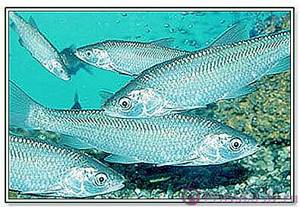
Spawning among dace is schooling, numerous and very noisy. In the groups, the predominant majority are females, males are almost half as numerous. Each female spawns from 100 to 13-15 thousand eggs to the bottom of the spawning ground.
Small whitish eggs, fertilized by males, are incubated for 10 days, after which larvae emerge. The fry grow very quickly: in the first year of life they reach 7-8 cm, and after the fourth year of development, adults grow to a maximum size of 20-25 cm and 200-250 g. Throughout the rest of their life, they no longer increase in height, only gain weight
Population and species status
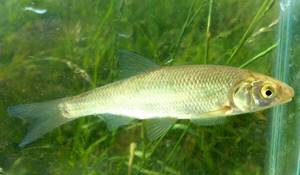
Photo: Siberian dace
The distribution area of the dace is quite extensive, but almost everywhere this fish species is becoming scarce and rare. Year after year, there are fewer and fewer clean, untouched reservoirs, which is why dace is becoming very rare, because it quickly dies in dirty waters.
Dace are not a commercial fish species, so they are not caught on a large scale. People cause damage to fish stocks by interfering with natural biotopes, polluting water bodies, dumping wastewater, pesticides, and oil products into them. A large number of fish die precisely because of poor quality water. In the south of Europe (Balkans), dace can no longer be found. In the waters of the central regions of our country, the number of this fish has also become extremely small. In some states, dace is considered very rare and even endangered.
Siberian dace is also experiencing a population decline. Back in the fifties of the last century, there were huge quantities of this small fish in the Transbaikal rivers. When it spawned in the shallows, due to its large numbers, even the bottom was not noticeable; the dace went to spawn in such dense schools. Now the population size of these fish has decreased enormously, because... The condition of water resources has deteriorated significantly. In this regard, it can be argued that dace needs special protective measures to preserve and stabilize fish numbers.
How to catch dace
It is recommended to catch the silvery omnivorous pest dace using a spinning rod, a donkey, a float, and, less often, using a retrieve and fly fishing. Regardless of the fishing method, you won’t be able to catch a lot of dace in one spot. Because of this, experienced fishermen rarely go for it purposefully; they focus more on the predator’s neighbors in the reservoir. In addition, it is not the most nutritious of carp species.
How to fish with a spinning rod
For catching a medium-sized dace of 200-350 g, a medium-length rod of 1.8–2 m with a powerful reel with an average reeling speed is suitable. A variety of insect imitators are suitable as bait: microwobblers, flies, spinners.
With all this arsenal, it is advisable to arrive at the water before dawn and get ready before the first fish rise from the bottom to hunt. Usually in summer the bite begins at dawn and ends closer to 7-8 pm.
Any place is suitable for fishing with a spinning rod. For example, you can look for thickets of coastal plants that have inclined their crowns towards the water. Hungry dace gather at such points, looking for insects and eggs laid on leaves and coastal algae. It is impossible not to notice them, because when swallowing food they make a characteristic squelching sound, and when the flock is large, the water in this place looks as if it is boiling.
How to catch dace using float tackle
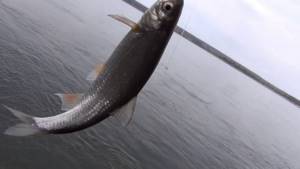
Fishing with a float is more difficult, but much more interesting for sport fishermen. The rod should be no longer than 3 m, otherwise it will be difficult to use it in places with dense green thickets that dace love so much.
It is advisable to choose a sinking bait. To do this, experienced fishermen unhook the float directly, leaving only the sinker and hook. Casting such a structure is not the most pleasant experience, because the line floats a lot, but the splash of the falling float will not scare away the impressionable prey
Caution is a must for successful dace fishing. This type of fish has excellent hearing and reacts to any extraneous sounds with mass panic, sometimes even affecting other inhabitants of the reservoir. If you behave quietly, you will be able to observe the whole process:
- the bait sinks to the bottom in clear river water;
- how a cautious dace approaches the bait that interests him;
- dace swallows the bait.
The main thing is not to miss the moment when the fish is hooked and make a quick but careful hook.
Fly fishing
For fly fishing, a rod of at least class five with a 3-centimeter leader and a floating line is recommended. Bait, if desired, can be taken live or artificial (flies, micro-spinners). When fly fishing for dace, casting is done from the shore against the current. Otherwise, the technique is no different from that suitable for other species of the carp family.
